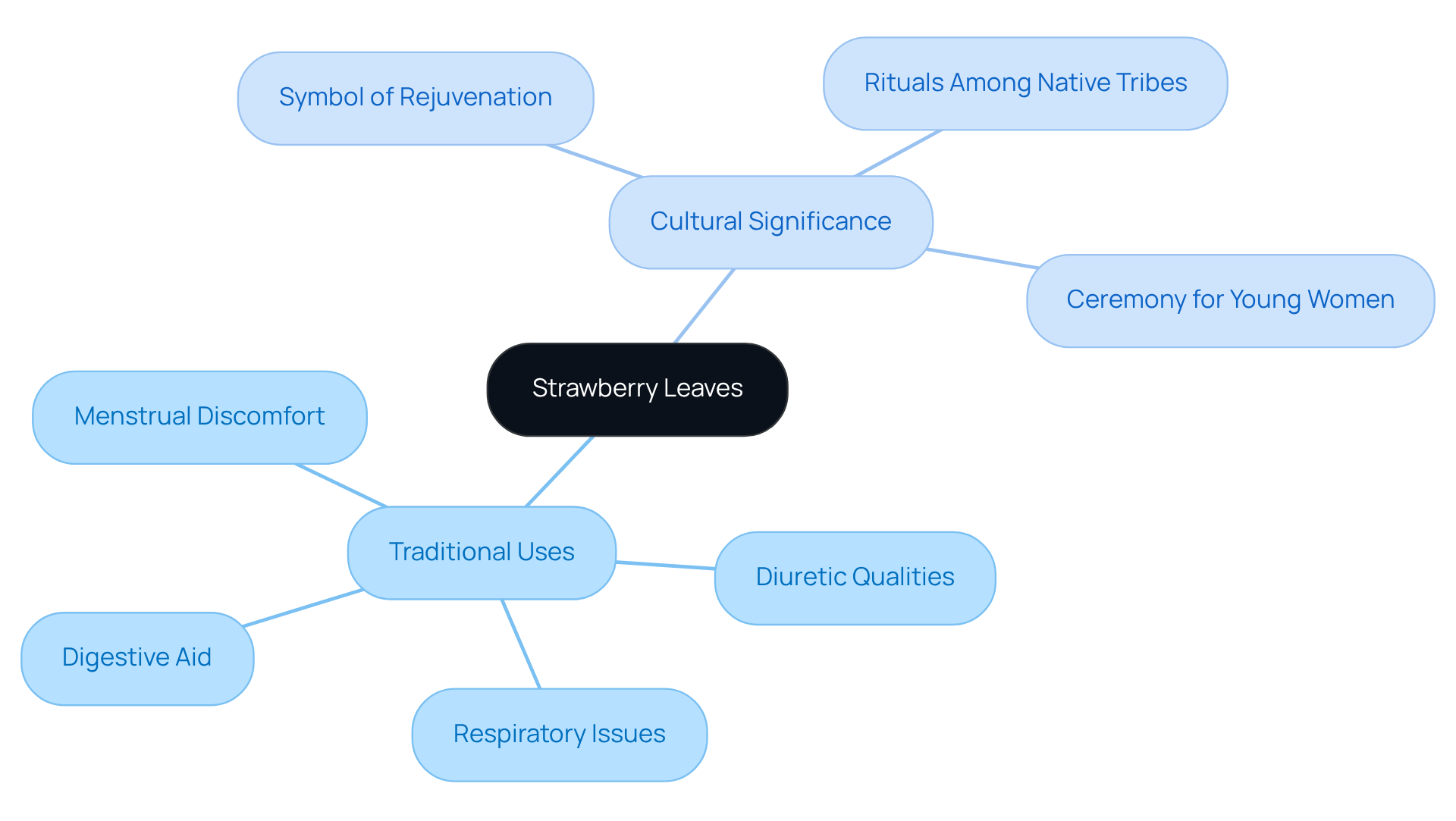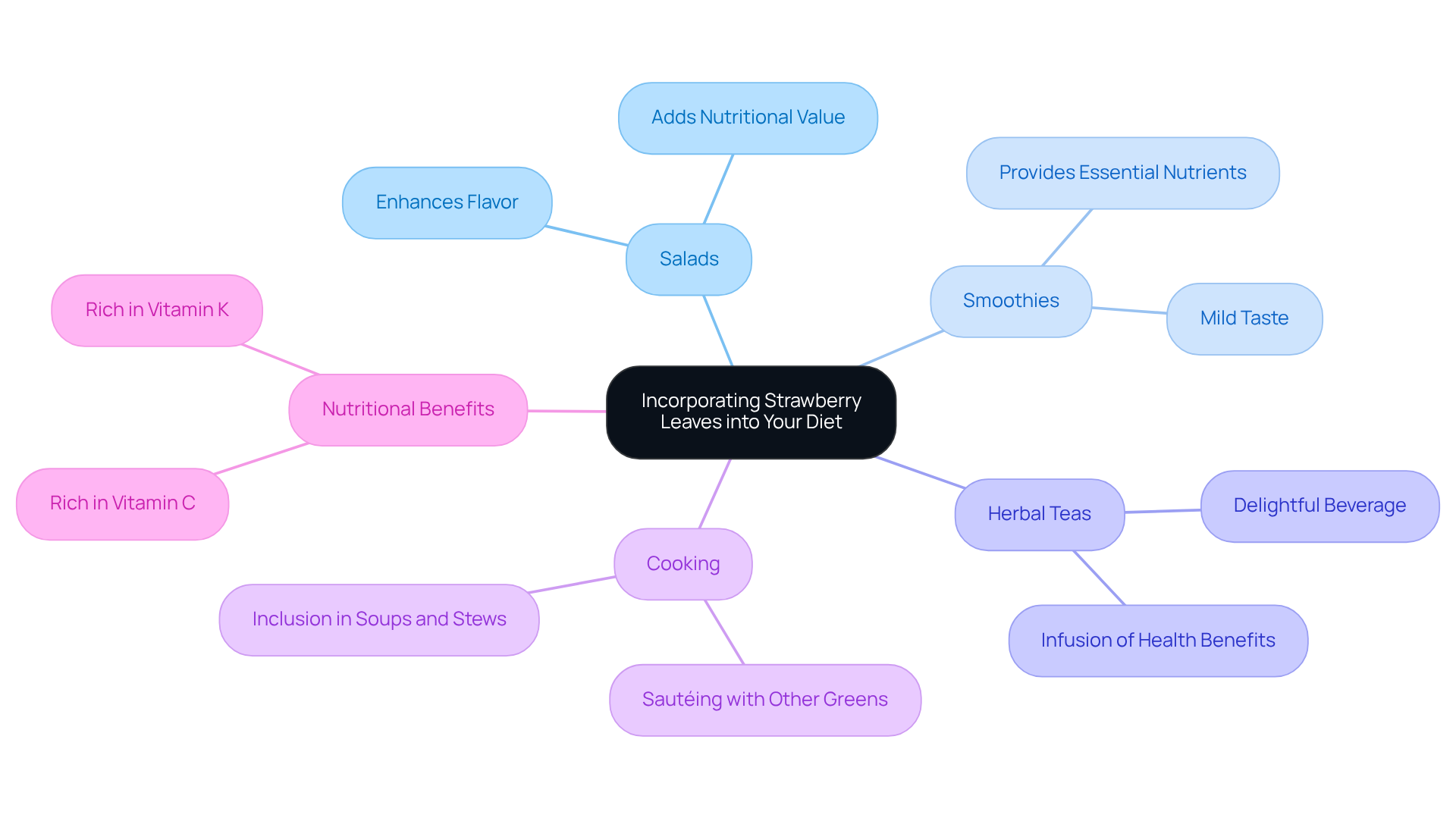Are Strawberry Leaves Good for You? Discover Their Health Benefits
Overview
Strawberry leaves are indeed beneficial for your health. Rich in essential vitamins and minerals, they support immune health, enhance bone strength, and promote overall vitality. Furthermore, these leaves possess antioxidant properties, regulate blood sugar levels, and have traditional medicinal uses. Incorporating strawberry leaves into your diet can provide numerous health benefits.
Consider the advantages: not only do they bolster your immune system, but they also contribute to stronger bones and improved vitality. As a result, adding strawberry leaves to your meals is a simple yet effective way to enhance your well-being. Explore further resources to learn how to incorporate these leaves into your daily diet.
Introduction
Strawberry leaves, often discarded without a second thought, are emerging as a nutritional powerhouse that deserves attention. Packed with essential vitamins, minerals, and antioxidants, these overlooked greens can significantly contribute to health and wellness, particularly in anti-aging strategies. As curiosity grows around their benefits, one question remains: are strawberry leaves truly good for you, or are they just another trendy health fad? This inquiry invites us to explore the potential of these leaves further, considering their impact on our overall well-being.
Explore the Nutritional Profile of Strawberry Leaves
Many people wonder if strawberry leaves are good for you, as they are often overlooked and discarded, yet surprisingly nutritious and can play a significant role in anti-aging dietary strategies. Rich in essential vitamins and minerals such as Vitamin C, Vitamin A, calcium, iron, and magnesium, these nutrients are vital for various bodily functions. They support immune health, enhance bone strength, and aid in energy production, all contributing to our overall vitality as we age.
Furthermore, the foliage of strawberries contains polyphenols, known for their antioxidant properties. These compounds help combat oxidative stress, a key factor in aging and chronic diseases. Additionally, the dietary fiber found in strawberry foliage promotes digestive health, making it a beneficial addition to a balanced diet.
Overall, the nutritional profile of strawberry foliage prompts the inquiry: are strawberry leaves good for you, positioning it as a valuable component of wellness strategies, particularly for those focused on anti-aging and rejuvenation practices. This aligns seamlessly with ByKomi.com’s commitment to empowering vibrant aging through quality nutrition. Consider incorporating strawberry foliage into your diet to find out if strawberry leaves are good for you and to harness its numerous health benefits.

Uncover the Health Benefits of Strawberry Leaves
There are numerous advantages of strawberry foliage, which raises the question: are strawberry leaves good for you as an excellent addition to any diet? Studies indicate that these plants can improve heart health by reducing cholesterol levels and supporting overall cardiovascular performance. Many people wonder if strawberry leaves are good for you, especially since they are rich in vitamin C, calcium, iron, and other essential minerals that contribute significantly to overall health.
Moreover, its ability to regulate blood sugar levels is particularly beneficial for individuals managing diabetes. Research suggests that the foliage may help lower blood glucose levels and enhance insulin sensitivity. The antioxidant properties of the berry plant’s foliage play a crucial role in reducing oxidative stress, which is linked to chronic diseases such as cancer and heart conditions.
In addition, traditional uses of berry foliage include aiding digestion and alleviating gastrointestinal discomfort due to its anti-inflammatory properties. This can be especially helpful for those suffering from conditions like arthritis, as the foliage may assist in reducing joint pain and swelling. Furthermore, the antimicrobial qualities of the berry plant’s foliage can aid in wound healing and infection prevention.
With its rich nutrient profile and various health benefits, including potential support for weight management, the question arises: are strawberry leaves good for you as they emerge as a valuable ally in the quest for longevity and overall well-being? This aligns with the innovative anti-aging strategies highlighted by Dr. Joseph Dituri’s underwater studies, which emphasize the importance of exploring diverse nutritional practices for optimal health.

Traditional Uses and Cultural Significance of Strawberry Leaves
Strawberry foliage has been essential to traditional medicine across various cultures for centuries. Often brewed into teas, it is recognized for aiding digestion and alleviating gastrointestinal distress. In many cultures, these plants are believed to possess diuretic qualities, assisting in toxin removal and enhancing kidney wellness. Additionally, they have been used to address respiratory issues and serve as a natural remedy for menstrual discomfort. Significantly, wild berry plant remedies have been safely utilized for at least 30 years, underscoring their enduring role in herbal traditions.
The cultural importance of berry foliage extends beyond therapeutic uses; they symbolize rejuvenation and energy, often celebrated during spring and harvest periods. Among the Wabanaki and other Native tribes, these berries are regarded as a woman’s medicine, deeply intertwined with cultural rituals and rites of passage. For instance, the ceremony for this fruit signifies important transitions in a girl’s life following her first menstrual cycle. Lynn Mitchell, a Passamaquoddy elder, emphasizes that these ceremonies empower young women, helping them embrace their menstrual cycles as sacred rather than shameful.
By understanding these customary applications, contemporary health enthusiasts can evaluate if strawberry leaves are good for you and appreciate the comprehensive advantages of the plant’s foliage. Integrating them into wellness routines offers a meaningful way to connect with both cultural heritage and natural health practices.

How to Incorporate Strawberry Leaves into Your Diet
Many people ask if strawberry leaves are good for you, and incorporating the foliage of berries into your diet is both simple and enjoyable, offering a unique flavor along with numerous nutritional benefits, particularly as they serve as a valuable source of vitamins C and K. Fresh berry leaves can be added to salads, enhancing the dish with their mild taste and additional vitamins. For a refreshing twist, consider blending them into smoothies, where they provide essential nutrients without dominating the flavor. Those who appreciate herbal teas can infuse dried fruit foliage in hot water, resulting in a delightful beverage that preserves its health-enhancing properties.
Strawberry foliage is also versatile in cooking; it can be sautéed with other greens or included in soups and stews, enriching the dish with its distinctive flavor and nutritional value. By experimenting with these methods, individuals can easily integrate berry foliage into their daily meals and discover if strawberry leaves are good for you, enjoying the myriad health benefits they present. As Robert Graves insightfully noted, the sweetness of berries, whether in fruit or foliage form, can elevate our culinary experiences, reminding us to appreciate the simple pleasures in life. Moreover, the popularity of these berries in various culinary applications underscores the importance of their leaves and raises the question, are strawberry leaves good for you, making them a valuable addition to any health-conscious kitchen. For those interested in cultivation, it’s important to note that strawberry plants thrive in conditions requiring at least six hours of direct sunlight and temperatures ranging from 45 to 85 degrees Fahrenheit.

Conclusion
Strawberry leaves, often overlooked, are a powerhouse of nutrients and health benefits that deserve attention. Their rich profile, including essential vitamins, minerals, and antioxidants, positions them as a valuable addition to any diet, particularly for those seeking to enhance their overall health and support anti-aging efforts. By incorporating strawberry foliage into daily meals, individuals can tap into a natural source of vitality and well-being.
The article highlights several key advantages of strawberry leaves, including their ability to:
- Promote heart health
- Regulate blood sugar levels
- Provide digestive support
Furthermore, their traditional uses in various cultures further emphasize their significance, showcasing their role not only in nutrition but also in cultural rituals and herbal medicine. From improving immune function to alleviating gastrointestinal discomfort, the myriad benefits of strawberry leaves make a compelling case for their inclusion in modern diets.
Ultimately, embracing strawberry leaves as part of a balanced diet is not just a culinary choice but a step toward holistic health. By exploring creative ways to incorporate this nutritious foliage into meals—whether in salads, smoothies, or herbal teas—individuals can enjoy the numerous health benefits while connecting with a rich cultural heritage. The question remains: are strawberry leaves good for you? The answer is a resounding yes, as they offer a delicious and health-enhancing option that aligns with a conscious approach to nutrition.
Frequently Asked Questions
Are strawberry leaves nutritious?
Yes, strawberry leaves are surprisingly nutritious, rich in essential vitamins and minerals such as Vitamin C, Vitamin A, calcium, iron, and magnesium.
What health benefits do strawberry leaves provide?
Strawberry leaves support immune health, enhance bone strength, aid in energy production, and promote digestive health due to their dietary fiber content.
How do strawberry leaves contribute to anti-aging strategies?
The polyphenols in strawberry leaves have antioxidant properties that help combat oxidative stress, a key factor in aging and chronic diseases.
Can strawberry leaves be included in a balanced diet?
Yes, incorporating strawberry leaves into your diet can be beneficial, particularly for those focused on anti-aging and rejuvenation practices.
What is the overall significance of strawberry leaves in wellness strategies?
Strawberry leaves are a valuable component of wellness strategies, especially for individuals looking to enhance their vitality and health as they age.






